Soil Indicators and Tests
Many indicators for monitoring soil health exist. It has been discussed for a long time which ones should be chosen to represent the best the state of the soil.
From what exists in the scientific literature, we have chosen this set of five soil indicators that are easy to measure (no need for a laboratory), cheap and easy to execute in the field without being an expert or having specialized equipment.
These soil tests will inform you about different physical, chemical and biological parameters.
Doing these 5 tests will give you a good idea about your soil health and what you need to do to improve it.
We recommend that you do all five tests in several locations to get a good picture of the health of the soil; do not forget to choose your reference site to be able to compare your results with and also along time.

Soil Indicators
The different indicators will inform you of soil problems and thus help you to find the adapted techniques to solve it.
- Soil texture can explain soil compaction (heavy clay), low water retention (sandy soil), possible erosion (silt rich soils).
- Soil structure will show you the aggregate size which informs you about soil compaction and aggregate stability in your soil that can inform about soil erosion (by strong wind or water like heavy rain event) .
- Earthworm counts inform you about the biology and life in your soil. If the organisms in the soil are not present, it negatively impacts soil microorganisms, decreases the amount and diversity of other soil organisms, and thus reduces soil fertility.
- Soil color is a proxy for organic matter presence in the soil. Light soil can indicate lack of fertility, and different colors like grey or blue can indicate a lack of oxygen in your soil which will impact your soil biology and decrease fertility.
- Soil water infiltration: it will tell you about soil compaction (if water can not infiltrate) or low soil water retention capacity of your soil thus limiting water available for your plants and soil organisms.
Important note: You can do these tests in any order but to optimize your time effort we recommend to do them in this order so that you dig one squared hole of 30×30 cm and can do your tests from this fieldwork (texture, structure, earthworms and color).
Here is the suggested order:
- Soil structure: observe and organize all the soil aggregates (drop and shatter) and select 1 or 2 aggregates for the slaking test;
- Soil texture: separate enough soil to do the jar test;
- Earthworms count: count all the earthworms present in the soil sample;
- Soil color: observe the color of the soil digged out and also the hole’s borders (easier);
- Soil water infiltration: near the hole, chose a place to do this test in an undisturbed area.
